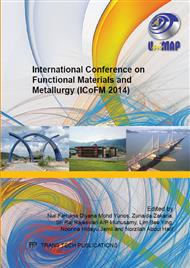p.337
p.341
p.347
p.353
p.361
p.367
p.373
p.381
p.387
The Development of Macroporous PEG-Based Hydrogel Scaffolds for Tissue Engineering Applications
Abstract:
The fabrication of porous poly (ethylene glycol) (PEG)-based hydrogel scaffolds via epoxy-amine crosslinked polymerization was conducted in this research works. PEG was chosen as the main component of the hydrogel scaffolds due to their unique characteristic including high hydrophilicity, biocompatibility and low toxicity properties. The effects of different solvents ((water, dimethylsulfoxide (DMSO), triethylene glycol dimethyl ether (TGDME), etc) toward physical and mechanical properties of fabricated PEG-based hydrogel scaffolds were investigated to identify the suitable solvent for fabrication of porous hydrogel scaffolds. From the results obtained, DMSO was selected as the solvent because the produced hydrogels scaffolds possessed the optimum physical properties as compared to other solvents. In tissue engineering field, porosity of scaffolds play key role for cell attachment, grow and proliferation consequently help in regeneration of new tissues. Therefore, in this study the macroporous hydrogel scaffolds were produced via introduction of fused salt templates in the range sizes of 100–300 μm (small) and 300–600 μm (large) in the fabrication process. Improved interconnectivity of pores was achieved and pores sizes obtained were according to the size of salt particles utilized in the template. Modification of the scaffolds pore morphology resulted in a reduction in the mechanical properties as we expected.
Info:
Periodical:
Pages:
361-366
Citation:
Online since:
June 2015
Authors:
Price:
Сopyright:
© 2015 Trans Tech Publications Ltd. All Rights Reserved
Share:
Citation:


